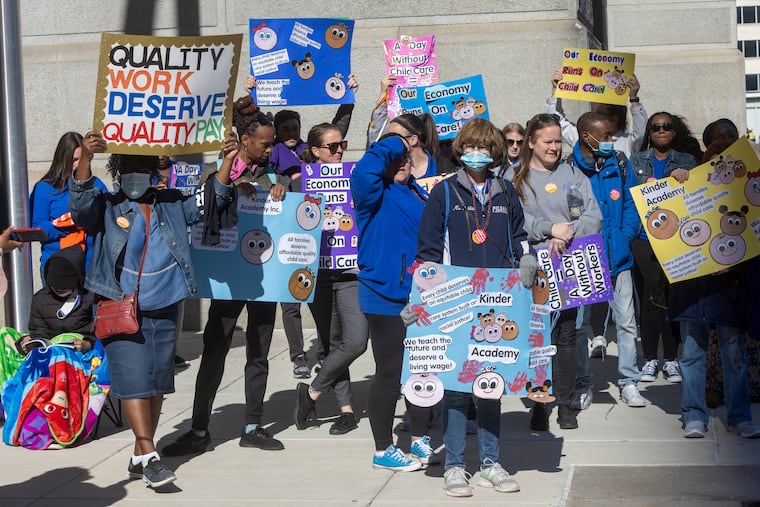More than 20 Philly child-care centers go on strike, pushing for better wages and more affordable care
More than 20 Philly child-care centers shut their doors Monday to demand local and federal leaders offer a lifeline to the struggling industry.

On a typical morning, Isis Brooks, 28, would wrap up breakfast and take her 4-year-old to Discovery Place Preschool in South Philly, which is only a few minutes from her job. But Discovery was closed Monday as part of a national “Day Without Child Care” protest, so Brooks’ son had to spend the day with his grandmother, an option that’s not always available.
“She called out [of work] to make it work,” said Brooks, describing how her family’s life would be upended if her four children, ranging from 4 to 10 years old, didn’t have access to child care.
As someone who works in the child-care industry herself, Brooks is familiar with what providers are calling a crisis decades in the making. With tight profit margins, workers are making too little and centers are struggling to recruit and keep hires. Meanwhile, families describe spending a significant portion of their income on care for their children.
Brooks joined a crowd of more than 100 child-care advocates in front of City Hall on Monday to demand living wages for child-care providers and affordable care for all families in a system “built on racial justice.”
The national group Community Change Action, which helps low-income and communities of color organize, led the national day of action, with 24 Philly centers taking part in the strike.
Advocates such as Shineal Hunter, who runs Family Center Academy in Olney, called on Congress to pass additional funding to help the industry.
Last year, Democrats proposed to inject billions into the industry as part of Build Back Better, President Joe Biden’s signature spending bill that ultimately collapsed, in an effort to “expand access to high-quality, affordable child care” and cap child-care costs for middle-class families, among other goals.
Still, Hunter and others pointed to funds already in Pennsylvania’s possession. In September, Gov. Tom Wolf’s administration announced it planned to distribute $655 million it had received through the American Rescue Plan in the form of grants. Licensed child-care centers could use funds for personnel and operational costs, as well as past COVID-19 expenses. As of last week, most of the funds had been distributed, with the average grant award slightly more than $109,000, according to the Department of Human Services. Pennsylvania has at least $97 million in additional federal funding set aside for child care. Those funds, according to DHS, are slated to be distributed in July and August.
”It’s just sitting there and it’s not being released to child-care providers and we’re not sure why,” said Hunter. “We’ve been asking and we haven’t been told why.”
Hunter said that without funds, operations like hers, which enrolled 50 children before the pandemic, might not be a resource to families in the years to come. Pandemic shutdowns led to the permanent closures of hundreds of licensed centers. Despite the losses, DHS reports an overall capacity increase of .78% and an 8% increase in capacity at the highest-rated providers since March 2020 — and Hunter said attracting talent has only become harder.
“How can I compete paying my staff $15 an hour, giving them time off, flexible hours when I don’t have the budget,” said Hunter. “And if you’re high quality, you have to have a research-based curriculum, you have to provide quality nutritious food, you have to make sure your staff has professional development. You have to pay your staff at a certain livable wage. So where is all this money coming from?”
Workers such as Rasheeda Brown, 39, described feeling as though her work goes largely unappreciated.
“I’m not a babysitter, I’m an educator,” Brown said as she described a day at the Children’s Playhouse with her group of children who range from 3½ to 5 years of age, which often requires managing their social and emotional needs.
“We’re teaching them, giving them story time, giving them love and nurturing.”
What’s more, Brown, who is Black, said it felt like women of color bear the brunt of the industry’s low wages working at an hourly pay that can range from $10 to low $20s, depending on certifications and degrees. Brown makes an hourly rate of $17.50, which is barely enough to cover her own child-care needs and outstanding school loans.
According to a 2021 U.S. Department of the Treasury report, women make up more than 90% of the child-care industry employees and more than a third are people of color.
The demands to give the industry a financial boost don’t come without criticism. Mainly, some experts worry about families flooding the already-stressed centers, increasing costs.
But workers such as Brooks say they can’t keep waiting for experts and politicians to figure out the future of child care. While child care is her calling, she said she has a family to care for and $20,000 in student loans. Her colleagues already know she’s going back to school to pursue a career in health care.
“I really love children,” she said. “I would stay if the pay got better.”